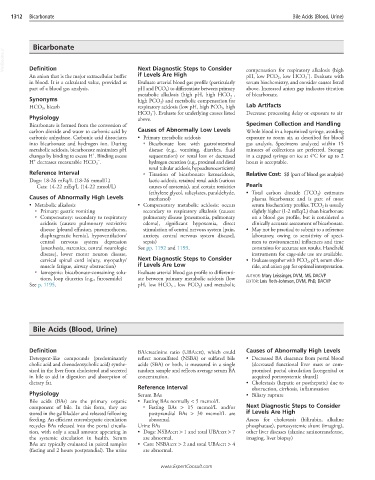Page 2593 - Cote clinical veterinary advisor dogs and cats 4th
P. 2593
1312 Bicarbonate Bile Acids (Blood, Urine)
Bicarbonate
VetBooks.ir Definition Next Diagnostic Steps to Consider
−
pH, low PCO 2 , low HCO 3 ). Evaluate with
An anion that is the major extracellular buffer if Levels Are High compensation for respiratory alkalosis (high
in blood. It is a calculated value, provided as Evaluate arterial blood gas profile (particularly serum biochemistry, and consider causes listed
part of a blood gas analysis. pH and PCO 2 ) to differentiate between primary above. Increased anion gap indicates titration
−
metabolic alkalosis (high pH, high HCO 3 , of bicarbonate.
Synonyms high PCO 2) and metabolic compensation for
HCO 3, bicarb respiratory acidosis (low pH, high PCO 2 , high Lab Artifacts
−
HCO 3 ). Evaluate for underlying causes listed Decrease: processing delay or exposure to air
Physiology above.
Bicarbonate is formed from the conversion of Specimen Collection and Handling
carbon dioxide and water to carbonic acid by Causes of Abnormally Low Levels Whole blood in a heparinized syringe, avoiding
carbonic anhydrase. Carbonic acid dissociates • Primary metabolic acidosis exposure to room air, as described for blood
into bicarbonate and hydrogen ion. During ○ Bicarbonate loss: with gastrointestinal gas analysis. Specimens analyzed within 15
metabolic acidosis, bicarbonate minimizes pH disease (e.g., vomiting, diarrhea, fluid minutes of collections are preferred. Storage
+
changes by binding to excess H . Binding excess sequestration) or renal loss or decreased in a capped syringe on ice at 4°C for up to 2
−
+
H decreases measurable HCO 3 . hydrogen excretion (e.g., proximal and distal hours is acceptable.
renal tubular acidosis, hypoadrenocorticism)
Reference Interval ○ Titration of bicarbonate: ketoacidosis, Relative Cost: $$ (part of blood gas analysis)
Dogs: 18-26 mEq/L (18-26 mmol/L) lactic acidosis, retained renal acids (various
Cats: 14-22 mEq/L (14-22 mmol/L) causes of azotemia), and certain toxicities Pearls
(ethylene glycol, salicylates, paraldehyde, • Total carbon dioxide (TCO 2 ) estimates
Causes of Abnormally High Levels methanol) plasma bicarbonate and is part of most
• Metabolic alkalosis • Compensatory metabolic acidosis: occurs serum biochemistry profiles. TCO 2 is usually
○ Primary: gastric vomiting secondary to respiratory alkalosis (causes: slightly higher (1-2 mEq/L) than bicarbonate
○ Compensatory: secondary to respiratory pulmonary disease [pneumonia, pulmonary on a blood gas profile, but is considered a
acidosis (causes: pulmonary restrictive edema], significant hypoxemia, direct clinically accurate assessment of bicarbonate.
disease [pleural effusion, pneumothorax, stimulation of central nervous system [pain, • May not be practical to submit to a reference
diaphragmatic hernia], hypoventilation/ anxiety, central nervous system disease], laboratory, owing to sensitivity of speci-
central nervous system depression sepsis) men to environmental influences and time
[anesthesia, narcotics, central neurologic See pp. 1192 and 1193. constraints for accurate test results. Handheld
disease], lower motor neuron disease, instruments for cage-side use are available.
cervical spinal cord injury, myopathy/ Next Diagnostic Steps to Consider • Evaluate together with PCO 2 , pH, serum chlo-
muscle fatigue, airway obstruction) if Levels Are Low ride, and anion gap for optimal interpretation.
○ Iatrogenic: bicarbonate-containing solu- Evaluate arterial blood gas profile to differenti-
tions, loop diuretics (e.g., furosemide) ate between primary metabolic acidosis (low AUTHOR: Mary Leissinger, DVM, MS, DACVP
−
See p. 1195. pH, low HCO 3 , low PCO 2) and metabolic EDITOR: Lois Roth-Johnson, DVM, PhD, DACVP
Bile Acids (Blood, Urine)
Definition BA/creatinine ratio (UBA:crt), which could Causes of Abnormally High Levels
Detergent-like compounds (predominantly reflect nonsulfated (NSBA) or sulfated bile • Decreased BA clearance from portal blood
cholic acid and chenodeoxycholic acid) synthe- acids (SBA) or both, is measured in a single (decreased functional liver mass or com-
sized in the liver from cholesterol and secreted random sample and reflects average serum BA promised portal circulation [congenital or
in bile to aid in digestion and absorption of concentration. acquired portosystemic shunt])
dietary fat. • Cholestasis (hepatic or posthepatic) due to
Reference Interval obstruction, cirrhosis, inflammation
Physiology Serum BAs • Biliary rupture
Bile acids (BAs) are the primary organic • Fasting BAs normally < 5 mcmol/L
component of bile. In this form, they are ○ Fasting BAs > 15 mcmol/L and/or Next Diagnostic Steps to Consider
stored in the gallbladder and released following postprandial BAs > 30 mcmol/L are if Levels Are High
feeding. An efficient enterohepatic circulation abnormal. Assess for cholestasis (bilirubin, alkaline
recycles BAs released into the portal circula- Urine BAs phosphatase), portosystemic shunt (imaging),
tion, with only a small amount appearing in • Dogs: NSBA:crt > 1 and total UBA:crt > 7 other liver diseases (alanine aminotransferase,
the systemic circulation in health. Serum are abnormal. imaging, liver biopsy)
BAs are typically evaluated in paired samples • Cats: NSBA:crt > 2 and total UBA:crt > 4
(fasting and 2 hours postprandial). The urine are abnormal.
www.ExpertConsult.com

